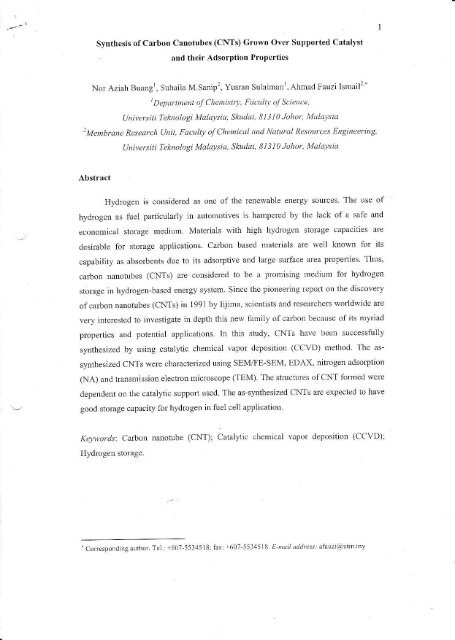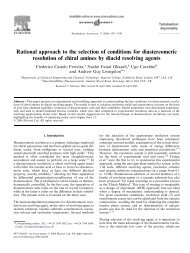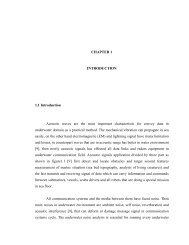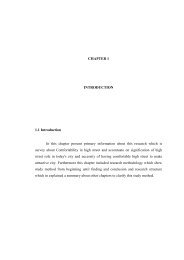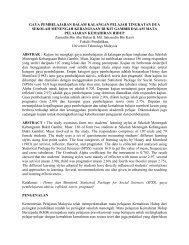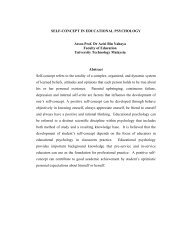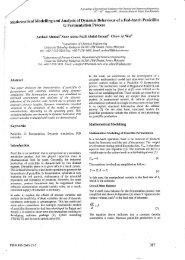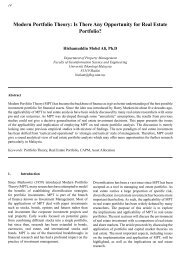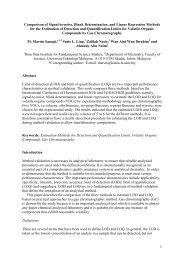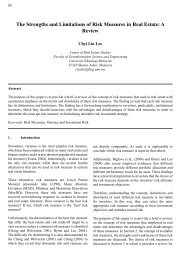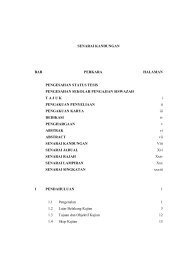Syrthesis of Carbon Canotubes (CNTS) Crown Over Srpported ...
Syrthesis of Carbon Canotubes (CNTS) Crown Over Srpported ...
Syrthesis of Carbon Canotubes (CNTS) Crown Over Srpported ...
Create successful ePaper yourself
Turn your PDF publications into a flip-book with our unique Google optimized e-Paper software.
<strong>Syrthesis</strong> <strong>of</strong> <strong>Carbon</strong> <strong>Canotubes</strong> (<strong>CNTS</strong>) <strong>Crown</strong> <strong>Over</strong> <strong>Srpported</strong> Catalyst<br />
and their AdsorPtion ProPerties<br />
Nor Aziah Buangr, Suhaila M.Sanipr. Yusran Sulaimanr. Ahlrad Fauzi Ismailr''<br />
tDeparhilent oJ Chenlstry, Faculty al Scie ce,<br />
Ltntuersiti Tekn.togi Malaysia, Skutlai, 3l3l0 Johar, MulLry:i.l<br />
zMenbrane Research LI it, FaLulty <strong>of</strong>Chetnicdl cLnd Natural Resour(:e's Engineering<br />
LriNersiti Teklologi MdLaysia, Skudai, 8l310 lohot Maldvsia<br />
Abstract<br />
Hydrogen is considered as orte <strong>of</strong> the renewable energy soluces. The use <strong>of</strong><br />
hydrogcn as fuel particularly in autoDlotives is hanpeled by the lack ol a safe and<br />
economical storage ll1edium. Maierials with higl hydrogen storage capacllles are<br />
desirable for storage applications <strong>Carbon</strong> based materials are well known for its<br />
capabilily as ebsorbents due to its adsolptive and large surface arel propefiies lhus,<br />
carbou runotubes (<strong>CNTS</strong>) are considered to be a pronising mediun,I for hydrogen<br />
storage in hydlogen-based energy system. Since the pioneering report on the discovery<br />
<strong>of</strong> carbon nanotubes (CNTs) in 1991 by Iiji1na, scientists and reseerche$ worldwide are<br />
very iDterested to jnvestigate in depth tlis ne\l family <strong>of</strong> carbon becarlse <strong>of</strong> rts myrrad<br />
properlies and potential applioations ln this study, ClN ls have been successfull)'<br />
synthesized by using catalytic chemical vapor depositioo (CICVD) method- The assynthesized<br />
<strong>CNTS</strong> were charact€rized using SEM/FE-SEM' ED{X' nitmgen adsolption<br />
(NA) ancl transmission electron microscope (TBM) The structures <strong>of</strong>CNT tbrmed were<br />
depenalent ou the catalytic suppott Lrsed. The as_slntbesized <strong>CNTS</strong> are expected to have<br />
good storage capacity for hydrcgen ill ftel cell application<br />
Ke)arolds: <strong>Carbon</strong> nanotube (CNT); Catalytic chenical vapor deposition (CIC'VD);<br />
Ilydrogen slorage.<br />
'Corespondlng aullr<strong>of</strong>. Tel, 601 55145l8:fax:l607551'15l3 E nujL a(1'lress:<br />
^t:rrtzl('!fin v
l.IDtrod[ction<br />
Today, 'nanotechnology' is a hot lopic attracting scientists, industrialists,<br />
joumalists, govefinenlts and everl the general public. Nanotechrrology is ihe crcaiion <strong>of</strong><br />
funclional materials, devices and system throlrgh conkol <strong>of</strong> oratter on the ianometer<br />
scale and the exploiiation o[ nove] phenonena and properties <strong>of</strong> nutter (physical'<br />
chernical, biological, electrical, etc) at thai length scale<br />
<strong>Carbon</strong> nanotubes (CNls) is oDe ol the key oomponents <strong>of</strong> nmotechnology<br />
Ever siice the discovery ot carlron ranotlrbe\ b) }jinlr lLr 1o')l Il]. it has cxptuLed the<br />
aftention olrcsearchers worldwide. LJnderstanclirg theil unique propcrties and explorirlg<br />
theil potential applications have been a main dliving fbrce jn this arca [2-5]<br />
<strong>Carbon</strong> natotubes, having unique geonetrical stmoture and stable nechanical<br />
and chet1lical prop€ftjes arc also an excelleot sounie ol hydrogen sklrage due to the'r<br />
relatively small surface and pore volume. Research findings have shown tl'Iat carbon<br />
nanotubes are able io store hydrogen 16]. Its capability to dbsorb and release hydrog"n<br />
Lrnder nornal atmospheric pressltle ard loderate tempemtufes would be a ma;or<br />
breakthrough fbr the tuel cell system<br />
The increasing demands lbr lnass production ol carbon nanotubes have resrllted<br />
in the development <strong>of</strong> new methods to produce carbon nanolubes Catalytio chemical<br />
vapour decon,posilion (CCVD) was found to be onc <strong>of</strong> lhe promisilg methods for the<br />
qnthesis ol <strong>CNTS</strong> al low tellperature and ambient pressure Conirolled sl.l1thesis<br />
irvolving CCVD has been studied as ar elLctive strategy to oldel or patlem <strong>CNTS</strong> on a<br />
variety <strong>of</strong> sufaces. Metal and mixture ot'metals supported on oxidcs, clays and zeolites<br />
have been fbunil to be active as catalysts in CC\rD rnethod lTl ln the field <strong>of</strong><br />
heterogeneous catalysis, a number <strong>of</strong> orides and mixed oxides heve been used to<br />
dispe$e and stabilize ruelallic perlicles Catalytio propefiies <strong>of</strong> these solids are kno$'n
to depcnd upon thc interaction between th€ suppotl aDd the netal pariicles, which i1<br />
tum d;pends on lheir method <strong>of</strong>preparation l8l. The syDthesis <strong>of</strong>ClNTs is carricd out in<br />
the tenpemture range <strong>of</strong> 500-1000 oC with a strean <strong>of</strong> hydrocarbon gas (methaDe,<br />
acetyleD€, etc.) diluted with inerl compounds suoh tls rihogen, argon- etc. The<br />
dissociatiou <strong>of</strong> the gas occtl$ at th€ hot catalyst surface The precipilalion <strong>of</strong> carboo<br />
liom the saturaled metal particle leads to the l'ormaiion <strong>of</strong> tubullr oarbol st11]ctures in<br />
the form <strong>of</strong>nanotubes or nanoibcrs l9l.<br />
In this work, we have attenpted to synthesize <strong>CNTS</strong> over alunlila and molecular<br />
sieve supported Fe. Co and Ni catalysts. The moryhologies <strong>of</strong>lhe as grown <strong>CNTS</strong> were<br />
analysed. In additioll, the €lfects oi dilfelent srLpporled catalysts and their potential<br />
adsolption properties were also investigated<br />
.J<br />
2. Experimental<br />
2. I Catalyst Prcpardtian<br />
Alumina (Alror) aDd l1]olecLLlal sieve (MS) beads obtained tiom ooNnercial<br />
sources \r€re Llsed as oalalyst supp<strong>of</strong>is. Both the supports were dried to eliminate water<br />
vapour and jmpLrdties prior to the addition <strong>of</strong>catalysts fhe catalysts w€re prepared by<br />
the impreglation rlethod. The supp<strong>of</strong>ts were immersed \l ith rnetai sali solution until<br />
saturation and dried overnighl. The prepared supported oatalysis wcre then used in the<br />
synthesis <strong>of</strong> CN'l's.<br />
2.2 CNTi Sy thesis<br />
A sillrple and inexpensive th€Dal catalytic chernical vapour deposition syslem<br />
has been ilesi$1ed. The experiments to produce <strong>CNTS</strong> were ca ed oui in a horizonlal<br />
tube fumace at atmospheric prcsslu€- The suppoded calalysts were placed inside a
quafiz tube. Acetylene gas, C2H2 was passed through to react $ith the catalysts. Tbe<br />
p}'ro)ysis <strong>of</strong> C2Hu was cafiied out at temperature > 600 'C. Pior to sanpiing, the<br />
rcaction chamber was cooled down to roon temperahlle. Thc samples \\'ere collected as<br />
l..a,'k pou der on thc crl-lv'l<br />
2.3 Charu.lerizati,t<br />
The surlace morphology anLl elements presert on thl] supp<strong>of</strong>i and catalysls were<br />
investigated Lrsing Scannirlg Electron Microscope (SEM) and Energy Dispelsive X ray<br />
Analysis (EDAX) (XL 40, Philips). The quality rnLl naflrrc <strong>of</strong> ihe aq-grown ('NTs were<br />
observed using SEM.<br />
The single poi1lt surface area was measurcd al 79K ( 196 'C) using a<br />
Micromeritics Pulse Che isolp 2705. The smlples wele outgassed using nltrogen gas<br />
1br l% holu at 350'C. The nitrogen adsorption-desorption was carried oul ir1 liquid<br />
nitrogen. The surlace aret measurement was repeated in tliplicate and all ar'erage <strong>of</strong>the<br />
peak al-ea w:rs taken. Reproducibility <strong>of</strong> the peak area was within I 0 02 Lrnits on the<br />
display ll1eter. The BET surface area was therefbre calculated as:<br />
BET (surface area) = Peak Area (m') / sample weight (g)<br />
(r)<br />
Tbe san,e apparams was also us€L] to measure lhe desorption <strong>of</strong> hydrogen a1<br />
ambientenperature a1ld pressure. A11 sarnples were outgassell in nikogen at 350"C for<br />
3 hours before saturation <strong>of</strong>hydroger taLes place. Saturation was carried out at ambient<br />
tempelaturc ancl pressure for t hour. The volume ot'gas desorbed lvas established usiDg<br />
the loop-volull]e calibration <strong>of</strong> the apparatus The volume <strong>of</strong> hydrogen desorhed<br />
corresponded to ihe peak area displayed
3. Results and Discussion<br />
The gro$4h process <strong>of</strong> <strong>CNTS</strong> was found to be strol1gly dependent on the<br />
catalysfsupport interaotion [9]. In a similar worh, it was rcportcd that sttpp<strong>of</strong>is play an<br />
el.ectr\e rol. rn e\po.rng lhc d.tr\e 'rle\ un lhe cdldllsl n]..d1" .or r \ f, pfo,ltrcllon<br />
The metals also have some degree <strong>of</strong>affinity to the support [10].<br />
The SEM images <strong>of</strong> lhe <strong>CNTS</strong> synthesized over different Nelal supporled<br />
catalysts at specific feaction te peratures arc shown in Figures 1 and 2 Al1 <strong>of</strong>the as_<br />
grown CNTs Nere exanined under tbe scanning el,:cffon microscopc without any<br />
pur;ficatioo. Results obtained showed that the as-gro*'n <strong>CNTS</strong> floss \\iere ir vanous<br />
fonns ard sizes. From ligures I (a)-(c), the growth demilies <strong>of</strong> <strong>CNTS</strong> over<br />
rnonometnllic alu ina-supp<strong>of</strong>ied catalyst were less dense es conpared with binetallic<br />
and trinetallic alumirla supp<strong>of</strong>ted catalyst, liigures I (d)-(e). h the later cases, the<br />
Ie/Co- AlrO: and Fe/Co,Ni- Alzor show€d excclienl aclivity in gro\ring align€d <strong>CNTS</strong><br />
floss. The deDsity <strong>of</strong>the aligned <strong>CNTS</strong> was cxtremely high almost co1'ering the surfaoe<br />
<strong>of</strong> the snpporicd calalyst.<br />
Sin'rilar pattems in the growth <strong>of</strong>the <strong>CNTS</strong> were obsened for <strong>CNTS</strong> floss grcwn<br />
over nolecular sieve-supporled catalysts- l'he as grown <strong>CNTS</strong> were less deuse and<br />
randomly grown on the surface <strong>of</strong> the MS support (Figurcs 2 (a)-(d)). Ii can also be<br />
observed that the <strong>CNTS</strong> floss grown over the Ms-supported catalysts, showed white<br />
spots at mosi <strong>of</strong>theil tubular tips,Iigure 3. These whiie spois originated irom the rrelrl<br />
cluster 1101. ]'his indicated thet the <strong>CNTS</strong> werc grcwn by the 'tip growth model' wlttl<br />
weak catalyst-support interactiorl [11]. The necessary carbon f-eed stock supplied [,,nr<br />
th.. catalylic decomposilion <strong>of</strong> acetylene dissolved in melallic species to lbrm<br />
metastable rn€liLl calbide. This metastable metal carbide will dissolve more carbon<br />
resulting ir en ove$atlrration olcarbon. Subsequ€ntly. graphio-carboN \lill precipate to<br />
form <strong>CNTS</strong> by keeping metallic cluster at dle tip <strong>of</strong>the tubes.
Fig. I . CN l's grown over alLIft ina supp<strong>of</strong>ed catallsts (a) Fe-Al:Or; (b) Co- A lror;<br />
(c) Fe/Cb Alror; (d) Ni- Al:Or; (e) Fg/CotNi- Al:Or<br />
Fig- L <strong>CNTS</strong> gforvn over N'lS suppo[cd catalysts (a) Fe-MS; (b) Co-MS; (c) Fe/Co-MS;<br />
(d) Nr MS;(e) l'c/Co,l\li- MS
ln the case olthe CNTs grown over aLumina-sLtppolted catalysls. the lips <strong>of</strong>lhe CN l s<br />
floss liossess less visible white spots. The <strong>CNTS</strong> were probablv grown by'base growth<br />
model' in which the catalysts have a strong cilla1ysl-slrpp<strong>of</strong>t inlefacLion. which enhanr"ed<br />
ll,e g'o\\lll ul . i"ncd cNT\<br />
1<br />
Table l<br />
Fig. L TEN4 ol'as-gro$'n <strong>CNTS</strong><br />
Analytical and desorption data <strong>of</strong>as_synthesized <strong>CNTS</strong> gfownover alumina (Al:Or)-<br />
suppolted catalysts.<br />
AlLrmina-supp<strong>of</strong>ted<br />
catalysts<br />
" <strong>Carbon</strong><br />
Composition (%)<br />
n Surface Area<br />
0,rt/s)<br />
Volulne <strong>of</strong>H, gas<br />
Desorped 0rl-/g)<br />
Ni-Atro3 i0 13 9,+<br />
Fe-AbO:: l9 90<br />
Co-Al:Or 4l 78 t9<br />
Fe/Co-Al:Oi 184<br />
Fe/Co/N;-AlrOr i.l 68 65
Tdble 2<br />
Analyiical and desorytion data <strong>of</strong> as-synthesized <strong>CNTS</strong> g1own over moleclrlar sieve<br />
(MS) supported catalysts.<br />
MS-sufp<strong>of</strong>ied cltllysts<br />
" <strong>Carbon</strong><br />
Co11]positior (%)<br />
: ED,{X. " : NA (Nitrogen Adsorptiorl). H2-TPD<br />
Sur lace Area<br />
('n'/c)<br />
Ni-N4S 59 t2<br />
" VolLxne <strong>of</strong>H2 gas<br />
Desoryed (n'[/g)<br />
Fe-MS 22 2-1<br />
Co-MS 10 11) 25<br />
Fe/Co-MS 6l 7T<br />
Fe/Co/Ni-MS 4) 63 65<br />
The EDAX data fron Tables I and 2 indicated thal all thc supp<strong>of</strong>ied catalysts<br />
werc sLrccesstul in producing <strong>CNTS</strong>- llhe k€y to obtainirg high yields <strong>of</strong> pure <strong>CNTS</strong> is<br />
aclieving hydrocarbon decomposition on catalysl sites alone and avoiding sponianeous<br />
pyrolysis [12]. Alunina lnalerials were lepolted to be a good supp<strong>of</strong>i owing to their<br />
strong metal-slrpport interaction, which allows high metal dispersion and, thus, a high<br />
dcnsity <strong>of</strong> catalytic sites. Such irlteractions pre!erlt rrelai spccies ftom aggregalirg and<br />
lbmring unwanted lar'ge clusters that lead to grapliie particles or defective ClNTs.'llhese<br />
facts explained that all the supp<strong>of</strong>ted catalysts rvere effective catdysts for <strong>CNTS</strong><br />
production, $ith F€/Co on alumina supp<strong>of</strong>ted catalysl giving the best yield oiCNTs.<br />
The BET surlace area in Tables 1 and 2 showed that alunila suppolted cataiysts<br />
gave lnrger surl'aoe ar€a than MS supp<strong>of</strong>ied ciaialysts. Ihe <strong>CNTS</strong> grown over bimeiallic<br />
and trinetaliic supported on both al mina and molecular sieve gavc the highest volume<br />
<strong>of</strong> hydrogen d€sorped rclative to the <strong>CNTS</strong> grown over monometallic supporled<br />
catalysts. This correlation belween surl'ace area and sorpiion ploperlies is in a!:reenent<br />
with the work done by Zuttel et dl, who found that levelsibie hydrogen sorptioll process<br />
takes place via physisorytioll in na ostruclurcd carbon and the amount <strong>of</strong> hydlogen
adsorbed was found to be proportional lo tie BET surface area <strong>of</strong> the nanostructured<br />
carbo;113 151.<br />
Frcm ihese sorptioll studi€s, we have come to a hlpothetical statenenthat the<br />
hydrogen molecules is probably bonded physically onto the. aligned and ordedy<br />
atranged <strong>CNTS</strong> structurcs, retained aDd snlliciently released when heat is introduced to<br />
the lMrogen stomge materials.<br />
Flence it may be possible to yield better quality and quantity <strong>of</strong> <strong>CNTS</strong> usjrg<br />
alumina supp<strong>of</strong>ted catalysts as good adsorbeut rnaterial ior hydrogen storage.<br />
v<br />
4. Conclusion<br />
<strong>Carbon</strong> nanotubes (<strong>CNTS</strong>) were successfully grown over alumtna and nolecular<br />
sieve suppoired catalysts by decomposilion <strong>of</strong> C2H2 It was obse ed that the yielLl <strong>of</strong><br />
<strong>CNTS</strong> highly depended upon lhe catalyst_support interaction. How€ver, the use <strong>of</strong><br />
bimetallic and trimetallic supported caialysls gave the best quality yield with high<br />
density ot ClNTs. Ie/Co on alumina r€corded the highest volume <strong>of</strong> desoryed hydrogen<br />
making it a potqntial candidate as hydrogerl storage matcrial. Based upon thesc<br />
prelininary firdings, a more conchrsive studies al differenl te peratures and pressLrres<br />
oladsorytion and desorption will be caried out to yield more signilicant results.<br />
Acknowledgemenl<br />
The authors would like ro thauk Minishf OfScience lechtology and Inoovation<br />
<strong>of</strong> Malaysia lor tunding tbis project under the IRPA mechanisn oI the National F el<br />
Cell proiect.
Referelrces<br />
t0<br />
[1] S. Iijima, Nalure.154 (1991) 56-58.<br />
[2] M.S. Dresselhaus, C. Dlesselhaus, and P. AvorLris, <strong>Carbon</strong> Nano[bes: Synthesis.<br />
Struclure, Propefiies and Applicarions, Spdnger-Verlag, Gemany, (2001).<br />
[3] M. Daenen, R.D. de FoLrw. B- Hamers, P.G.A., Janssen, K. Schouteden. and M.A.J.<br />
Veld, The WondrouS World <strong>of</strong><strong>Carbon</strong> Nanotubes. Denmark / Eindhoven<br />
University <strong>of</strong> Technology, 2003, unpublished.<br />
l4 R. Saito. C. Dresselhaus, and M.S. Dresselhalrs, lhysical Propefiies <strong>of</strong>Calbon<br />
Natotubes, Imp€rial College Press, London, 199E.<br />
l5l V. N. Popov. Materials Science and Engmeenrg: R: Reports.,ll (2003) 6l-102<br />
- [6]F.L. Darkim, P. Malbmnot, G.P. Iartaglia,Int. J. <strong>of</strong>llydrogcn Energy,27 (2002)<br />
193 202<br />
[7] N. Nagaraju, A. Fonseca, Z. Konya and J.B. Nagy, .J. Mol. Catalysis .4: Chemical.<br />
lE | ( 'r'n2)


